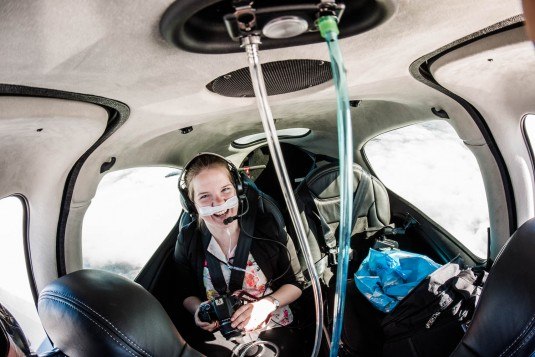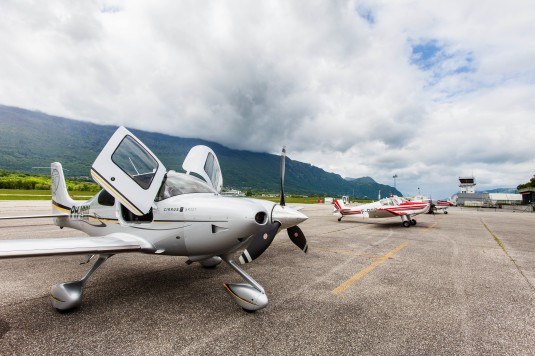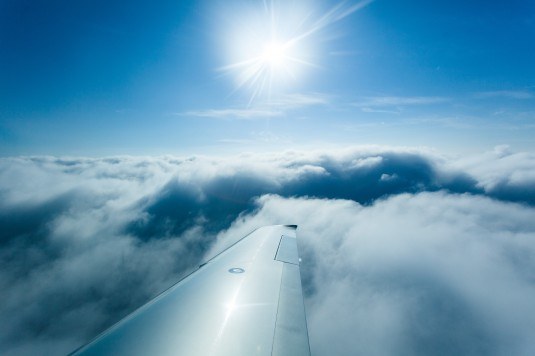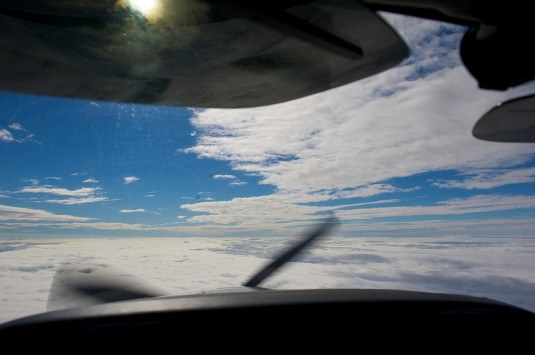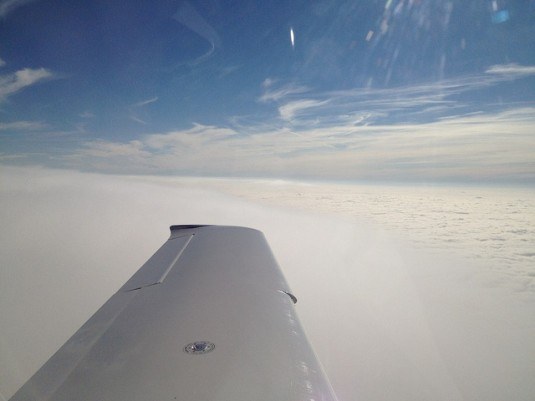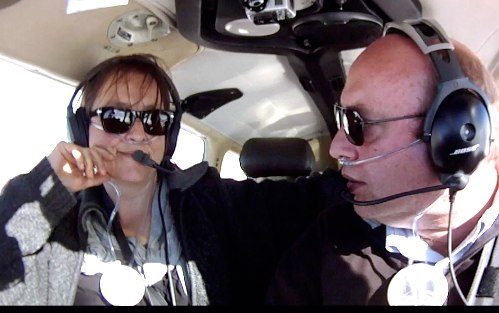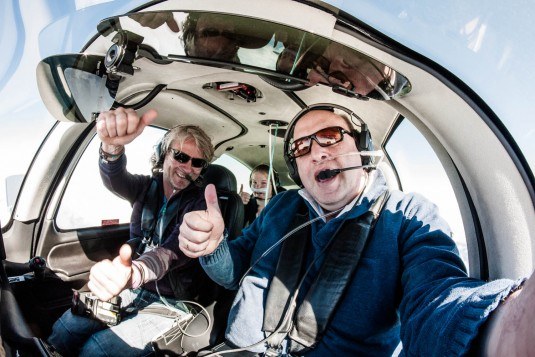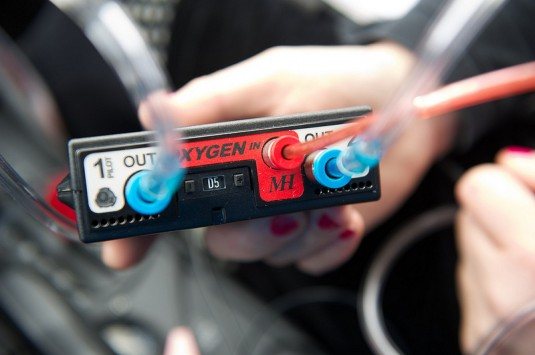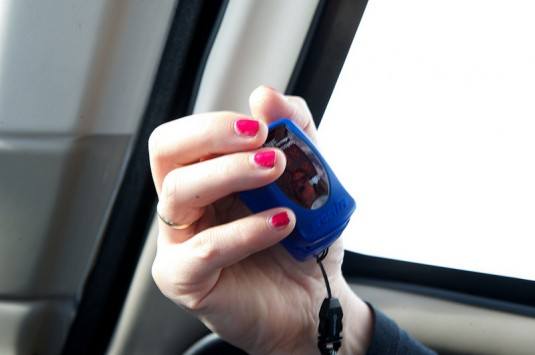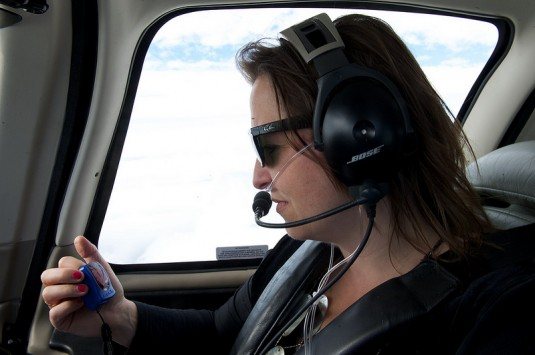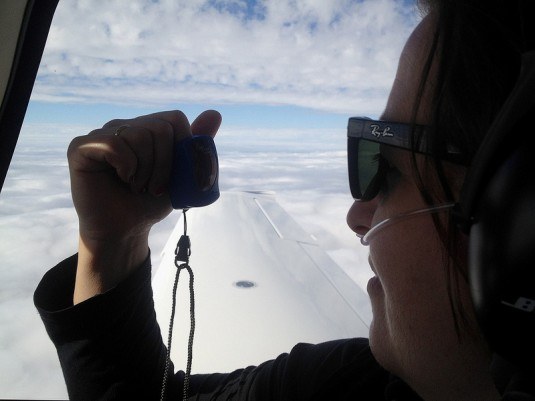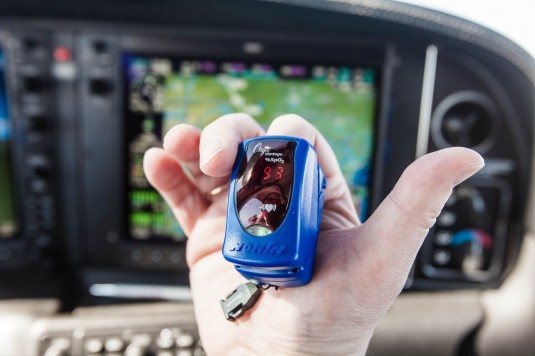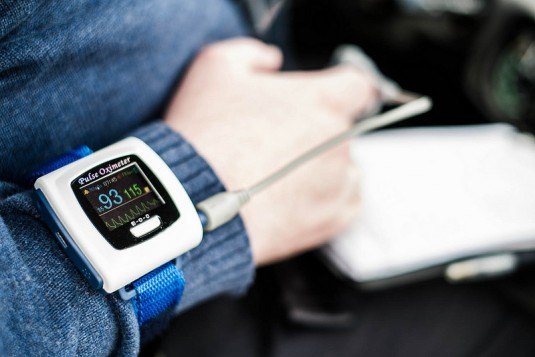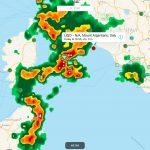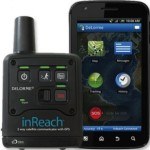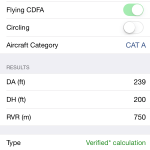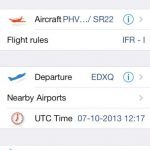Flying on Supplemental Oxygen
Jets and airliners utilise pressurised cabins, where the air pressure inside the aircraft is kept at an artificial low altitude at which altitude you do not need any supplemental oxygen. When flying in a non-pressurized aircraft and you aim to fly high, you need extra pure oxygen.
Up high in the air and without the protection of the pressure cabin, the oxygen in the air is still about 21% of the air you breathe. However, even though the percentage of oxygen in air remains constant at different altitudes, the fall in atmospheric pressure at higher altitude decreases the partial pressure of inspired oxygen and therefore the driving pressure for gas exchange in the lungs.
Passenger in the back of Cirrus SR22T with a built-in oxygen system.
Pilots flying at higher altitudes in nonpressurized aircraft have to deal with this and be aware of the risks involved in flying high, like the possible lack of oxygen (hypoxia risk).
Why do pilots run the extra risks involved in flying high if they can fly lower and remain safe? The answer lies in (a) getting extra performance and speed at the higher levels, (b) being able to out-climb any bad weather below and (c) flying in potentially more stable air up high which results in a smoother flight for the passengers. In addition, the winds aloft may be more favourable up high. Finally, altitude is your friend. When you run into trouble up high, you basically have more time to weigh the options compared to a pilot flying low. My mother said to me: “son, be careful out there. Fly low and slow”. The better advise to pilots is to fly higher where possible and reasonable.
Altitude is your friend
The indicated airspeed (IAS) is the airspeed read directly from the airspeed indicator on an aircraft, driven by the pitot-static system. Since the airspeed indicator cannot know air density or thickness of the air found around the aircraft, it is by design calibrated to assume the sea level density or thickness of the air when calculating airspeed. Since the actual density will vary considerably from this assumed value as the aircraft changes altitude, IAS varies considerably from true airspeed (TAS), the relative velocity between the aircraft and the surrounding air mass. As most pilots know, the general rule of thumb is that TAS increases 2% per 1000 ft climb in altitude. So flying at 10.000 feet increases your speed by 20%. The air is thinner up high and produces less drag flying through it. The combustion process in the engine might not be as optimal up high as it is at sea level. However, the loss in engine performance is less than the gain in speed from the thinner air and less drag induced at higher altitudes. All of this works to a certain altitude, after which other factors will come into play to reduce the benefits of flying even higher.
Cirrus SR22 Turbo aircraft with built-in Oxygen system and service ceiling of 25.000 feet.
Since I am flying a Cirrus SR22T aircraft with a turbo charged engine, the engine performs just about as well at sea level as at a higher altitude. In a way, the turbo-charged engine does not “know” at what altitude I am flying. However, since the air is also thinner at higher altitudes, the thinner air produces less drag on the aircraft and thus the aircraft flying high flies ‘easier’ through the air and gains more airspeed. Each aircraft has its own performance charts and figures and thus has its own optimal altitude at which it flies at its best. In most cases, aircraft gain from flying higher.
Favourable weather and winds
Weather plays an important role in flight as well. Being able to out-climb bad weather to a level of flight above the clouds means that the rain, clouds and other weather-related shit is left below you and thus does not affect your remaining flight. You would still have to climb to altitude and in the arrival phase of the flight descent to your destination. Maybe the weather is forecasted to be better at destination. Or the severe turbulence is only found in the lower layer up to 3000 feet. Or the winds aloft en route is forecasted to be optimal at higher altitudes. There are lots of reasons why you should always at least consider flying at a high altitude.
Climbing through a thin cloud layer to fly on top.
Flying top-of-clouds in good weather conditions.
18.000 feet = my ideal flying altitude
At an altitude of 18.000 feet, I get a true airspeed of a little more or less than 200 knots in the Cirrus SR22 Turbo. Flying at a higher altitude than this means that I would have to accept more risks involved with getting hypoxia. The oxygen supply system in the aircraft could fail to supply me with sufficient amounts of oxygen. Also, above 18.000 feet, oxygen masks might have to be used instead of cannulas.
Flying over the Alps at 15.000 feet in a Piper Archer II with a portable O2-system wearing cannulas.
Flying at 18.000 feet or below, wearing cannulas suffices. Cannulas are way more comfortable to wear than face-masks, as you can continue to talk and eat while wearing the cannula. Wearing a mask makes this more difficult. The Oxyarm cannula solution is an even more comfortable solution. It is a transparent stick connected to your headset. To get the extra oxygen you just move the transparent stick in front of your nose. Using the Oxyarm means extra comfort. You hardly notice anymore that you are connected to an oxygen system.
Pilot wearing Oxyarm cannula for optimal comfort.
Not taking other aspects, such as the winds aloft at different altitudes, freezing levels, convective clouds and frontal systems, into consideration, I often decide to fly at FL180 or 18.000 feet: best true airspeed performance, often a smooth ride for my passengers and in many cases a flight above the active weather playing down below.
Pulse regulators
I started out using a small portable oxygen system from SkyOx. You can already buy a simple portable oxygen set for a few hundred euro or dollar. My initial set consisted of a small portable oxygen bottle, a constant flow oxygen regulator and up to 4 cannulas connected to it. When turned on, the oxygen flows out of the bottle at a constant rate. After a while, you will start to notice that the constant flow of oxygen dries out your nose and throat on longer flights. Also, the bottle is empty before you know it. The alternative is to either buy a larger oxygen bottle or to use an oxygen regulator that provides oxygen to you and your crew only when needed. This last option saves a huge amount of oxygen and since the oxygen is not flowing anymore in a continuous flow but in pulses, your nose and throat do not dry out anymore that easily as well. These smart regulators are called pulse regulators. Mountain High is a leading supplier to these pulse demand oxygen regulators.
O2D2 Pulse regulator from Mountain High.
The Pulse regulator system from Mountain High can be linked to either a portable oxygen bottle or to your aircraft oxygen system. The pulse regulator can be configured to only provide oxygen starting from, for example, a density altitude of 5000 feet as can be seen in the image above (D5 = density altitude 5000 feet). When descending, the pulse regulator will automatically stop the oxygen supply when flying through 5000 feet.
Monitoring oxygen saturation levels
When flying high using a supplemental oxygen system, it is essential to monitor the system and be assured that the oxygen saturation level in your blood remains high enough and the supply of oxygen is not obstructed. Ideally, the oxygen saturation level value in your blood remains above 90%. Using a saturation meter you can easily check your current saturation level.
Using an oximeter in flight.
The Onyx oximeter I use myself is easy to use by both pilot and passengers. The finger is inserted at the top and a display will give the oxygen saturation level in percentage within seconds. An alternative solution is a ‘wrist-watch’ with a finger sensor. For passengers you would like to monitor, this is a great solution as you can configure the oximeter to alert you when the saturation level drops below e.g. 85%. However, for crew members, the finger probe is a hindrance and sits in the way of using the radios and flight controls.
When to fly low
There are of course situations when I prefer to fly low. One instance is when flying in the area of embedded thunderstorms or CB clouds. You don’t want to end up flying in one of these clouds. The visibility is often quite good below the cloud base with this kind of weather and with a better opportunity to spot the bad weather and to divert around it. In some instances like this, it might even be ill-advised to fly IFR in IMC conditions and to climb into the clouds. A maybe better alternative would be to stay below the clouds and remain VMC but with a clear view on the weather around you and a way to circumvent the bad stuff. The other reason I fly low sometimes is to stay out of the freezing danger zone while in the clouds. By flying below the freezing level, I almost fully rule out the risk of airframe icing. Since the Cirrus I fly is approved to fly into known icing conditions (FIKI approved = flight into known icing), I usually do not have to consider this last option, unless there is a forecast of severe ice and/or freezing rain.
VFR pilots should consider flying higher
When I fly together with ‘VFR Only’ pilots, most of them are not used to fly any higher than 2, 3 or maybe 4000 feet. They either believe that flying higher than that is only meant for IFR traffic. Or they were never taught to fly high during their initial flight training and simply do not have the habit. However, in almost all cases, the higher altitudes are also available to VFR pilots. Flying high gives them the same advantages as mentioned above. In addition, flying high often results in less complicated flying. The airspace is less complicated up high with no CTRs and less restricted/prohibited areas to bump into. A higher altitude gives more options in case of an engine failure and often also means a more stable and less turbulent flight experience for your passengers. The only difference is, that when flying VFR only, you have to be assured that you can climb to the top-of-clouds (it there are any clouds of course) and also that at your destination you will be able to descent again at your destination airfield without getting stuck in or above the clouds while remaining VMC. Pilots flying with a British license might want to check if they are allowed to fly under VFR rules out of sight of the ground (VFR-on-top). Other than that, I would strongly advise VFR pilots to consider always flying at as high an altitude as feasible. Consider using supplemental oxygen and discover a new dimension to your flight experience.
